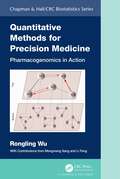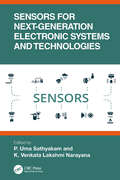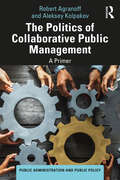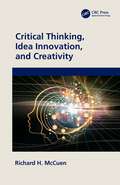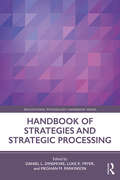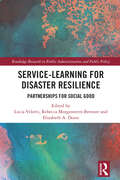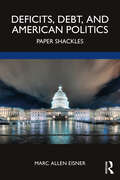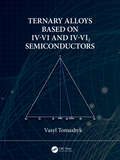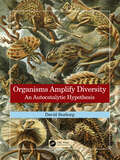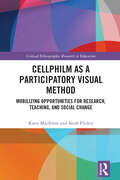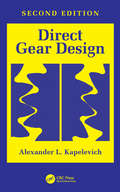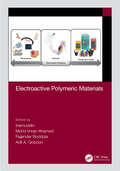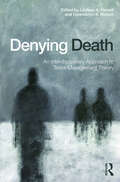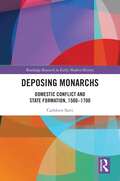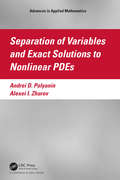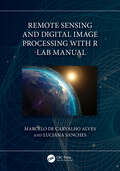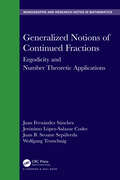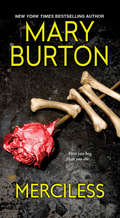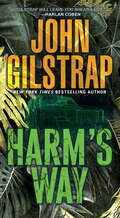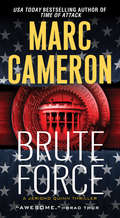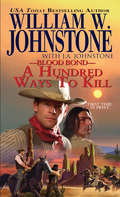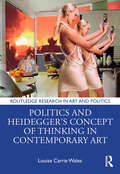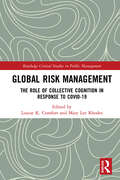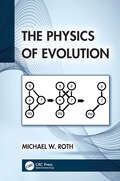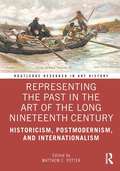- Table View
- List View
Quantitative Methods for Precision Medicine: Pharmacogenomics in Action (Chapman & Hall/CRC Biostatistics Series)
by Rongling WuModern medicine is undergoing a paradigm shift from a "one-size-fits-all" strategy to a more precise patient-customized therapy and medication plan. While the success of precision medicine relies on the level of pharmacogenomic knowledge, dissecting the genetic mechanisms of drug response in a sufficient detail requires powerful computational tools. Quantitative Methods for Precision Medicine: Pharmacogenomics in Action presents the advanced statistical methods for mapping pharmacogenetic control by integrating pharmacokinetic and pharmacodynamic principles of drug-body interactions. Beyond traditional reductionist-based statistical genetic approaches, statistical formulization in this book synthesizes elements of multiple disciplines to infer, visualize, and track how pharmacogenes interact together as an intricate but well-coordinated system to mediate patient-specific drug response.Features: Functional and systems mapping models to characterize the genetic architecture of multiple medication processes Statistical methods for analyzing informative missing data in pharmacogenetic association studies Functional graph theory of inferring genetic interaction networks from association data Leveraging the concept of epistasis to capture its bidirectional, signed and weighted properties Modeling gene-induced cell-cell crosstalk and its impact on drug response A graph model of drug-drug interactions in combination therapies Critical methodological issues to improve pharmacogenomic research as the cornerstone of precision medicine This book is suitable for graduate students and researchers in the fields of biology, medicine, bioinformatics and drug design and delivery who are interested in statistical and computational modelling of biological processes and systems. It may also serve as a major reference for applied mathematicians, computer scientists, and statisticians who attempt to develop algorithmic tools for genetic mapping, systems pharmacogenomics and systems biology. It can be used as both a textbook and research reference. Professionals in pharmaceutical sectors who design drugs and clinical doctors who deliver drugs will also find it useful.
Sensors for Next-Generation Electronic Systems and Technologies
by P. Uma Sathyakam K. Venkata Lakshmi NarayanaThe text covers fiber optic sensors for biosensing and photo-detection, graphene and CNT-based sensors for glucose, cholesterol, and dopamine detection, and implantable sensors for detecting physiological, bio-electrical, biochemical, and metabolic changes in a comprehensive manner. It further presents a chapter on sensors for military and aerospace applications. It will be useful for senior undergraduate, graduate students, and academic researchers in the fields of electrical engineering, electronics, and communication engineering.The book Discusses implantable sensors for detecting physiological, bio-electrical, biochemical, and metabolic changes Covers applications of sensors in diverse fields including healthcare, industrial flow, consumer electronics, and military Includes experimental studies such as the detection of biomolecules using SPR sensors and electrochemical sensors for biomolecule detection Presents artificial neural networks (ANN) based industrial flow sensor modeling Highlights case studies on surface plasmon resonance sensors, MEMS-based fluidic sensors, and MEMS-based electrochemical gas sensors The text presents case studies on surface plasmon resonance sensors, MEMS-based fluidic sensors, and MEMS-based electrochemical gas sensors in a single volume. The text will be useful for senior undergraduate, graduate students, and academic researchers in the fields of electrical engineering, electronics, and communication engineering.
The Politics of Collaborative Public Management: A Primer (Public Administration and Public Policy)
by Robert Agranoff Aleksey KolpakovAlthough one often thinks of collaborative management and related group problem-solving as different interests coming together in "peaceful harmony," nothing could be further from reality. Collaboration in real-world action requires steering and negotiation in virtually every situation, with a considerable process that precedes agreement. This progression is, in effect, a "mini" political and managerial process we have come to know as collaborative politics and its management. This volume explores the process and operations of collaboration and collaborative politics, from routine transactions—or "small p" politics—to the significant issue forces, or "big P" politics. Collaboration is defined here as the process of facilitating and operating in multiorganizational arrangements for addressing problems and producing solutions through the contributions of several organizations and individuals. Throughout the book, readers are gradually exposed to analysis of key findings in collaborative politics from the long research tradition in policy and political science. This book adapts a series of stories to highlight some of the dynamics of collaborative politics from a range of jurisdictions. It further analyzes the efficacy of storytelling as a learning tool and contributor to practice in different contexts. With collaborative politics often associated with negotiations among administrative actors, authors Drs. Robert Agranoff and Aleksey Kolpakov demonstrate how interorganizational/interagency collaboration operates and is managed, as well as how it has been modified or adjusted in its fundamental core concepts of bureaucratic organization and hierarchy. The Politics of Collaborative Public Management is designed as a core text for undergraduate and graduate classes on collaborative management and governance.
Critical Thinking, Idea Innovation, and Creativity
by Richard H. McCuenUsing topics of critical and creative thinking, Critical Thinking, Idea Innovation, and Creativity discusses methods of solving complex problems, demonstrates the benefits of using the methods of imaginative thinking, identifies ways to overcome problems and inhibitors such as a lack of confidence, provides guidelines for assessing creative experiences, and encourages the application of the methods to leadership, research, and decision-making. It allows readers to turn their unidimensional technical knowledge into a multi-dimensional knowledge framework that will provide a broader and more realistic framework for the solution of complex problems. Emphasis is placed on the fundamental concepts of critical and creative thinking and idea innovation, and each chapter presents numerous activities to accompany the knowledge-based educational material provided.Features: Provides educational material on creativity in a format that stresses application. An array of creative thinking tools will enable the reader to develop imaginative ideas. Emphasizes ways that critical thinking, idea innovation, and creativity can enhance a reader’s ability to solve problems related to leadership, the conduct of research, making decisions, and solving complex problems. Focuses on ways to improve the reader’s thinking skills, which will enhance the likelihood of developing novel solutions to complex problems; this skill set includes skills like curiosity, questioning, and skepticism, which are central to efficiently solving complex problems and meeting the requirements of effective leadership. Includes numerous activities in each chapter that will enable readers to apply the methods and develop actual experience in critical and creative thinking; these activities are appropriate for use either by individuals or by small groups.
Handbook of Strategies and Strategic Processing (Educational Psychology Handbook)
by Daniel L. Dinsmore, Luke K. Fryer, Meghan M. ParkinsonHandbook of Strategies and Strategic Processing provides a state-of-the-art synthesis of conceptual, measurement, and analytical issues regarding learning strategies and strategic processing. Contributions by educational psychology experts present the clearest-yet definition of this essential and quickly evolving component of numerous theoretical frameworks that operate across academic domains. This volume addresses the most current research and theory on the nature of strategies and performance, mechanisms for unearthing individuals’ strategic behaviors, and both long-established and emerging techniques for data analysis and interpretation.
Service-Learning for Disaster Resilience: Partnerships for Social Good (Routledge Research in Public Administration and Public Policy)
by Lucia Velotti Rebecca Morgenstern Brenner Elizabeth A. DunnThis book is the first to discuss, in practical and theoretical terms, the pedagogical approach of service-learning to establish partnerships for social good that build disaster resilience. Across 12 chapters a collection of academics and practitioners provide insights on the benefits of utilizing service-learning to address existing needs, build community capacity, and strengthen social networks while enhancing student learning.Key features: Discuss how sustainable service-learning partnerships can contribute to building disaster-resilient communities; Provide practical tools to cultivate and manage collaborative partnerships, and engage in reflective practices; Integrate disciplines to create innovative approaches to complex problems; Share best practices, lessons learned, and case examples that identify strategies for integrating service-learning and research into course design; Offer considerations for ethical decision-making and for the development of equitable solutions when engaging with stakeholders; Identify strategies to bridge the gap between academia and practice while highlighting resources that institutions of higher education can contribute toward disaster preparedness, response, recovery, and mitigation. Service-Learning for Disaster Resilience will serve as a user-friendly guide for universities, local government agencies, emergency management professionals, community leaders, and grassroots initiatives in affected communities.
Deficits, Debt, and American Politics: Paper Shackles
by Marc Allen Eisner"For most of the history of the United States, periods of growing indebtedness—a product of wars and economic crises—were followed by reductions in the debt-to-GDP ratio." But why have the last several decades failed to follow this pattern, leaving the national debt at its highest level since World War II? In this groundbreaking new book, author Marc Allen Eisner, who has devoted most of his scholarly career to studying the evolution of the US political economy, explores the significant changes in the fiscal conditions of the United States during the postwar period, embedding the discussion in a broader historical context. He demonstrates that the national debt is in part a product of reduced revenues and the growing costs of the largest entitlement programs, but it also reflects a long series of shocks, including two wars, the financial crisis and Great Recession, and the COVID-19 pandemic. Deficits, Debt, and American Politics chronicles the history of the US debt in the postwar period, placed in the context of broader changes in the political economy and partisan politics. But it grounds this exploration in reader-friendly, chapter-length discussions of public finance, taxation, mandatory spending, and the budgetary process from a policy perspective. The volume concludes with a discussion of the challenges of comprehensive tax and program reforms in the current political climate.Deficits, Debt, and American Politics assumes little prior knowledge on the part of the reader, making it an ideal book for courses on public policy and political economy taught at both the upper-level undergraduate and graduate level. The material on public finance, long-term trends in taxation and spending, and the budgetary process, often relegated to descriptive texts, will be invaluable in courses engaging the deficit and debt.
Ternary Alloys Based on IV-VI and IV-VI2 Semiconductors
by Vasyl TomashykIV-VI and IV-VI2 semiconductors are among the most interesting materials in semiconductor physics. The electrical properties of these semiconductors can also be tuned by adding impurity atoms. These semiconductors either have already found use or are promising materials for infrared sensors and sources, thermoelectric elements, solar cells, memory elements, etc. The basic characteristics of these compounds, namely, narrow bandgap, high permittivity, relatively high radiation resistance, high mobility of charge carriers, and high bond ionicity, are unique among semiconductor substances. Because of their wide application in various devices, the search for new semiconductor materials and the improvement of existing materials is an important field of study. Doping with impurities is a common method of modifying and diversifying the properties of physical and chemical semiconductors. This book covers all known information about phase relations in ternary systems based on IV-VI and IV-VI2 semiconductors, providing the first systematic account of phase equilibria in ternary systems and making research originally published in Russia accessible to the wider scientific community. This book will be of interest to undergraduate and graduate students studying materials science, solid state chemistry, and engineering. It will also be relevant for researchers at industrial and national laboratories, in addition to phase diagram researchers, inorganic chemists, and solid-state physicists.FEATURES Provides up-to-date experimental and theoretical information Allows readers to synthesize semiconducting materials with predetermined properties Delivers a critical evaluation of many industrially important systems presented in the form of two-dimensional sections for the condensed phases
Organisms Amplify Diversity: An Autocatalytic Hypothesis
by David SeaborgThis book presents a hypothesis and evidence that organisms promote and ecosystems maximize biodiversity. All species have a net positive effect on their environment, other species, and diversity. The sun is 30% hotter than when life began, but the temperature has been kept moderate by life. Life created high oxygen, the ozone layer, and fertile soil, a diverse, living system. No species evolves in isolation, and most evolution is coevolution. The nature and number of links between species are as important as species number. Eukaryotes coevolve with complex ecosystems of microbes with which they exchange genes. Genomes and intraspecific interactions both act to promote evolution and diversification. Viruses increase diversity of their hosts and cause macroevolutionary transitions. Key Features Life alters the Earth in ways that increase biodiversity All species make their environment better for other species and promote diversity Life created the life-friendly atmosphere, temperature, and soil of today
Cellphilm as a Participatory Visual Method: Mobilizing Opportunities for Research, Teaching, and Social Change (Critical Ethnographic Research in Education)
by Katie MacEntee Sarah FlickerThis volume celebrates cellphilm as an emerging Participatory Visual Method which effectively and powerfully engenders learning and catalyses social change. The book outlines the method’s theoretical framework, the role of the educator and researcher, and ethical concerns of using this method, and critically explores issues which determine the production and dissemination of creative outputs. The authors demonstrate the emerging methodology of cellphilm and how it can be utilised from both pedagogical and methodological standpoints. Using examples of cellphilms created to understand social issues, this book illustrates how the method enables diverse populations to document their communities and realities using mobile devices.By exploring cellphilm as a growing method in participatory visual research, the work fills an important gap in the fields of critically engaged community-based research, pedagogy and higher education for scholars and community activists.
Direct Gear Design
by Alexander L. KapelevichThe updated and improved second edition of Direct Gear Design details a nonstandard gear design approach that makes it possible to significantly improve gear drive performance. Providing engineers with gear design solutions beyond standard limits, this book delivers engineers with practical and innovative solutions to optimize gearing technologies.The majority of modern gears are over-standardized, not allowing gear design engineers to see possible gear design solutions outside of standard limits. The book explores opportunities to improve and optimize gears beyond these limitations. The method of Direct Gear Design has been proven to maximise gear drive performance, increase transmission load capacity and efficiency, and reduce size and weight. Discussing the use of gears made from powder metal and plastic, the book surveys gear manufacture and makes use of extensive references to encourage further exploration of gear design innovation. Additionally, the book provides an overview of manufacturing technologies and traditional gear design, as well as covering topics such as asymmetric gears, tolerance selection and measurement methods of custom gears.Written accessibly, with a focus on practical examples, this fully updated edition will serve as a guidebook for all professionals exploring high-performance gearing system technologies.
Electroactive Polymeric Materials
by InamuddinElectroactive polymers are smart materials that can undergo size or shape structural deformations in the presence of an electrical field. These lightweight polymeric materials possess properties such as flexibility, cost-effectiveness, rapid response time, easy controllability (especially physical to electrical), and low power consumption. Electroactive Polymeric Materials examines the history, progress, synthesis, and characterization of electroactive polymers and then details their application and potential in fields including biomedical science, environmental remediation, renewable energy, robotics, sensors and textiles. Highlighting the flexibility, lightweight, cost-effective, rapid response time, easy controllability, and low power consumption characteristics of electroactive polymers, respected authors in the field explore their use in sensors, actuators, MEMS, biomedical apparatus, energy storage, packaging, textiles, and corrosion protection to provide readers with a powerhouse of a reference to use for their own endeavors. Features: Explores the most recent advances in all categories of ionic/electroactive polymer composite materials Includes basic science, addresses novel topics, and covers multifunctional applications in one resource Suitable for newcomers, academicians, scientists and R&D industrial experts working in polymer technologies .
Denying Death: An Interdisciplinary Approach to Terror Management Theory
by Lindsey A. Harvell Gwendelyn S. NisbettThis volume is the first to showcase the interdisciplinary nature of Terror Management Theory, providing a detailed overview of how rich and diverse the field has become since the late 1980s, and where it is going in the future. It offers perspectives from psychology, political science, communication, health, sociology, business, marketing and cultural studies, among others, and in the process reveals how our existential ponderings permeate our behavior in almost every area of our lives. It will interest a wide range of upper-level students and researchers who want an overview of past and current TMT research and how it may be applied to their own research interests.
Deposing Monarchs: Domestic Conflict and State Formation, 1500-1700 (Routledge Research in Early Modern History)
by Cathleen SartiDeposing Monarchs analyses depositions in Northern Europe between 1500 and 1700 as a type of frequent political conflict which allows to present new ideas on early modern state formation, monarchy, and the conventions of royal rulership. The book revises earlier conceptualizations of depositions as isolated, unique events that emerged in the context of national historiographies. An examination of the official legitimations of depositions reveals that in times of crisis, concepts of tradition, rule of law, and political consensus are much more influential than the divine right of kings. Tracing the similarities and differences of depositions in Northern Europe transnationally and diachronically, the book shows monarchical succession as more non-linear than previously presumed. It offers a transferable model of the different elements needed in depositions, such as opposition to the monarch by multiple groups in a realm, the need for a convincing rival candidate, and a legitimation based on political traditions or religious ideas. Furthermore, the book bolsters our understanding of authority and rule as a constant process of negotiation, adding to recent research on political culture, and on the cultural history of politics.
Separation of Variables and Exact Solutions to Nonlinear PDEs (ISSN)
by Andrei D. Polyanin Alexei I. ZhurovSeparation of Variables and Exact Solutions to Nonlinear PDEs is devoted to describing and applying methods of generalized and functional separation of variables used to find exact solutions of nonlinear partial differential equations (PDEs). It also presents the direct method of symmetry reductions and its more general version. In addition, the authors describe the differential constraint method, which generalizes many other exact methods.The presentation involves numerous examples of utilizing the methods to find exact solutions to specific nonlinear equations of mathematical physics. The equations of heat and mass transfer, wave theory, hydrodynamics, nonlinear optics, combustion theory, chemical technology, biology, and other disciplines are studied.Particular attention is paid to nonlinear equations of a reasonably general form that depend on one or several arbitrary functions. Such equations are the most difficult to analyze. Their exact solutions are of significant practical interest, as they are suitable to assess the accuracy of various approximate analytical and numerical methods.The book contains new material previously unpublished in monographs. It is intended for a broad audience of scientists, engineers, instructors, and students specializing in applied and computational mathematics, theoretical physics, mechanics, control theory, chemical engineering science, and other disciplines. Individual sections of the book and examples are suitable for lecture courses on partial differential equations, equations of mathematical physics, and methods of mathematical physics, for delivering special courses and for practical training.
Remote Sensing and Digital Image Processing with R - Lab Manual
by Marcelo de Carvalho Alves Luciana SanchesThis Lab Manual is a companion to the textbook Remote Sensing and Digital Image Processing with R. It covers examples of natural resource data analysis applications including numerous, practical problem-solving exercises, and case studies that use the free and open-source platform R. The intuitive, structural workflow helps students better understand a scientific approach to each case study in the book and learn how to replicate, transplant, and expand the workflow for further exploration with new data, models, and areas of interest. Features Aims to expand theoretical approaches of remote sensing and digital image processing through multidisciplinary applications using R and R packages. Engages students in learning theory through hands-on real-life projects. All chapters are structured with solved exercises and homework and encourage readers to understand the potential and the limitations of the environments. Covers data analysis in the free and open-source R platform, which makes remote sensing accessible to anyone with a computer. Explores current trends and developments in remote sensing in homework assignments with data to further explore the use of free multispectral remote sensing data, including very high spatial resolution information. Undergraduate- and graduate-level students will benefit from the exercises in this Lab Manual, because they are applicable to a variety of subjects including environmental science, agriculture engineering, as well as natural and social sciences. Students will gain a deeper understanding and first-hand experience with remote sensing and digital processing, with a learn-by-doing methodology using applicable examples in natural resources.
Generalized Notions of Continued Fractions: Ergodicity and Number Theoretic Applications (Chapman & Hall/CRC Monographs and Research Notes in Mathematics)
by Juan Fernández Sánchez Jerónimo López-Salazar Codes Juan B. Seoane Sepúlveda Wolfgang TrutschnigAncient times witnessed the origins of the theory of continued fractions. Throughout time, mathematical geniuses such as Euclid, Aryabhata, Fibonacci, Bombelli, Wallis, Huygens, or Euler have made significant contributions to the development of this famous theory, and it continues to evolve today, especially as a means of linking different areas of mathematics.This book, whose primary audience is graduate students and senior researchers, is motivated by the fascinating interrelations between ergodic theory and number theory (as established since the 1950s). It examines several generalizations and extensions of classical continued fractions, including generalized Lehner, simple, and Hirzebruch-Jung continued fractions. After deriving invariant ergodic measures for each of the underlying transformations on [0,1] it is shown that any of the famous formulas, going back to Khintchine and Levy, carry over to more general settings. Complementing these results, the entropy of the transformations is calculated and the natural extensions of the dynamical systems to [0,1]2 are analyzed. Features Suitable for graduate students and senior researchers Written by international senior experts in number theory Contains the basic background, including some elementary results, that the reader may need to know before hand, making it a self-contained volume
Merciless (Senseless Duo #2)
by Mary BurtonThe New York Times bestselling author&’s &“latest romantic suspense has it all—terrific plot, complex and engaging protagonists, a twisted villain&” (Erica Spindler). No Pity Each skeleton is flawless—gleaming white and perfectly preserved, a testament to his skill. Every scrap of flesh has been removed to reveal the glistening bone beneath. And the collection is growing . . . No Compassion When bleached human bones are identified as belonging to a former patient of Dr. James Dixon, Detective Malcolm Kier suspects the worst. Dixon was recently acquitted of attempted murder, thanks to defense attorney Angie Carlson. But as the body count rises, Kier is convinced that Angie is now the target of a brutal, brilliant psychopath. No Escape Angie is no stranger to the dark side of human nature. But nothing has prepared her for the decades-long legacy of madness and murder about to be revealed—or a killer ready to claim her as his ultimate trophy . . . &“Terrifying . . . this chilling thriller is an engrossing story.&” —Library Journal &“[A] feverish sequel to Senseless . . . convincing detective lingo and an appropriately shivery murder venue go a long way.&”—Publishers WeeklyPraise for the novels of Mary Burton &“Absolutely chilling.&”—Brenda Novak &“A twisted tale . . . I couldn't put it down!&”—Lisa Jackson &“Taut, compelling . . . delivers a page-turner.&”—Carla Neggers &“A chilling thriller.&”—Beverly Barton
Harm's Way (A Jonathan Grave Thriller #15)
by John GilstrapThe exhilarating new thriller from the New York Times and USA Today bestselling author takes readers on an action-packed thrill ride across rural Venezuela. The kidnappers are ruthless. The stakes are high. The odds are impossible. There&’s no way Jonathan Grave can say no… &“[Gilstrap&’s] greatest strength is the ability to blend breathtaking action with deep emotion regarding the characters.&” —Jeffery Deaver Henchmen of a vicious drug syndicate have snatched ten missionaries in a remote area of Venezuela and are holding them for ransom. The high-priority rescue op comes as a personal plea from FBI Director Irene Rivers, who has a very special interest in one of the hostages. The mission is strictly off the books, and there can be no international incident. Just get in and get out—and keep the precious cargo safe. With his key operatives Gunslinger and Boxers, Grave infiltrates the enemy camp. Right away, the rescue mission morphs into something far more dangerous—not just to Jonathan and his team, but to the whole world.&“I read HARM&’S WAY in one sitting, including through dinner. Loved the book! John Gilstrap fast became one of my favorite authors. I look forward to many more good reads like this one.&” –Fern Michaels
Brute Force (A Jericho Quinn Thriller #6)
by Marc CameronAre these the last days of America? A thriller starring &“a compelling, never-give-an-inch hero who will appeal to Jack Reacher fans&” (Booklist). In the aftermath of a devastating biological attack, America stands on the brink of disaster. The President of the United States is controlled by terrorists. The Vice President, global mastermind Lee McKeon, is plotting his next move. And special agent Jericho Quinn is running for his life. Desperate to clear his name—and expose the conspirators in the White House—Quinn must race against time before McKeon can execute his evil plan. It begins with heightened security, mass surveillance, and the establishment of a brutal police state. It can only end in the takeover of America. The only thing standing between democracy and destruction is a man named Quinn…and one perfectly aimed bullet. From the New York Times-bestselling author of Tom Clancy Oath of Office, this heart-pounding thriller features &“a formidable warrior readers will want to see more of&” (Publishers Weekly).
A Hundred Ways to Kill: A Hundred Ways to Kill (Blood Bond #16)
by William W. Johnstone J.A. JohnstoneThese blood brothers are gunslingers with a conscience—and red-hot lead. Sharp-shooting adventure from the greatest Western writers of the 21st century. Young Matt Bodine and Sam Two Wolves became blood brothers on the day the rancher&’s son saved the warrior&’s life, forging a bond no one could ever break. And as years passed, a legend grew of the Cheyenne and the white man who rode together—and who could jerk killing iron with the best of them . . . A Hundred Ways to Kill Heading west to San Diego some honest pilgrims pay good money to keep their wagon train safe, but their guards soon turn against their charges and head off to Mexico with six young girls captive. When word reaches Tombstone—where Matt Bodine and Sam Two Wolves are wearing out their welcome gambling with Wyatt Earp—they know they have to do something about it. But it&’s going to take more than their bravery and shooting skills to rescue those girls from the merciless white slavers. On the way to Mexico, Matt and Sam ride into a war party of Apaches. They&’ll be facing outlaws and furious Apaches at the same time. For two blood brothers, the idea is to rescue those girls and blast their way North to freedom—no matter how many bullets it takes, or how many guns are shooting back . . . Praise for the novels of William W. Johnstone &“[A] rousing, two-fisted saga of the growing American frontier.&”—Publishers Weekly on Eyes of Eagles &“There&’s plenty of gunplay and fast-paced action.&”—Curled Up with a Good Book on Dead Before Sundown
Politics and Heidegger’s Concept of Thinking in Contemporary Art (Routledge Research in Art and Politics)
by Louise Carrie WalesResponding to Heidegger’s stark warnings concerning the essence of technology, this book demonstrates art’s capacity to emancipate the life-world from globalized technological enframing. Louise Carrie Wales presents the work of five contemporary artists – Martha Rosler, Christian Boltanski, Krzysztof Wodiczko, and collaborators Noorafshan Mirza and Brad Butler – who challenge our thinking and compel a dramatic re-positioning of social norms and hidden beliefs. The through-line is rooted in Heidegger’s question posed at the conclusion of his technology essay as understood through artworks that provides a counter to enframing while using increasingly sophisticated technological methods. The themes are political in nature and continue to have profound resonance in today’s geopolitical climate. The book will be of interest to scholars working in art history, aesthetics, philosophy, and visual culture.
Global Risk Management: The Role of Collective Cognition in Response to COVID-19 (ISSN)
by Louise K. Comfort Mary Lee RhodesThe rise and spread of Covid-19 in the beginning of 2020 presents a once-in-a-century challenge and opportunity for decision makers, managers, scholars, and citizens to understand the risks, mitigate its impact and prepare for future crises. Drawing on a global network of scholars, this book presents a comparative analysis of ten nations’ response to a global pandemic, while operating nominally under the framework of the World Health Organization. The book introduces the concept of ‘collective cognition’ as an analytic lens for examining the nations’ response to Covid-19 during the first six months of the emerging pandemic (January – June 2020) and draws out insights for improving systems of global risk management. This book addresses four primary audiences: policy-makers and leaders in nations struggling to contain viruses while guiding their societies under threat; academic researchers, students, and educators engaged in preparing the next generation of professionals committed to investigating emerging risk: managers of non-profit and private organizations that operate and maintain the networks of social, technical, and economic services that are essential to functioning communities; and the informed general public interested in understanding this extraordinary sequence of events and in managing the novel risk of COVID-19 in a more informed, responsible way.
The Physics of Evolution
by Michael W. RothThis book provides an introduction to the significant role of physics in evolution, based on the ideas of matter and energy resource flow, organism self-copying, and ecological change. The text employs these ideas to create quantitative models for important evolutionary processes.Many fields of science and engineering have come up against the problem of complex design—when details become so numerous that computer power alone cannot make progress. Nature solved the complex-design problem using evolution, yet how it did so has been a mystery. Both laboratory experiments and computer-simulation attempts eventually stopped evolving. Something more than Darwin’s ideas of heredity, variation, and selection was needed. The solution is that there is a fourth element to evolution: ecological change. When a new variation is selected, this can change the ecology, and the new ecology can create new opportunities for even more new variations to be selected. Through this endless cycle, complexity can grow automatically. This book uses the physics of resource flow to describe this process in detail, developing quantitative models for many evolutionary processes, including selection, multicellularity, coevolution, sexual reproduction, and the Serengeti Rules. The text demonstrates that these models are in conceptual agreement with numerous examples of biological phenomena, and reveals, through physics, how complex design can arise naturally. This will serve as a key text on the part physics plays in evolution, and will be of great interest to students at the university level and above studying biophysics, physics, systems biology, and related fields.
Representing the Past in the Art of the Long Nineteenth Century: Historicism, Postmodernism, and Internationalism (Routledge Research in Art History)
by Matthew C. PotterThis edited collection explores the intersection of historical studies and the artistic representation of the past in the long nineteenth century. The case studies provide not just an account of the pursuit of history in art within Western Europe but also examples from beyond that sphere. These cover canonical and conventional examples of history painting as well as more inclusive, ‘popular’ and vernacular visual cultural phenomena. General themes explored include the problematics internal to the theory and practice of academic history painting and historical genre painting, including compositional devices and the authenticity of artefacts depicted; relationships of power and purpose in historical art; the use of historical art for alternative Liberal and authoritarian ideals; the international cross-fertilisation of ideas about historical art; and exploration of the diverse influences of socioeconomic and geopolitical factors. This book will be of particular interest to scholars of the histories of nineteenth-century art and culture.
